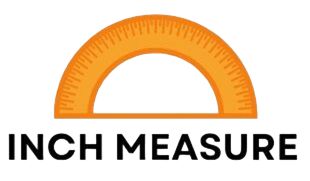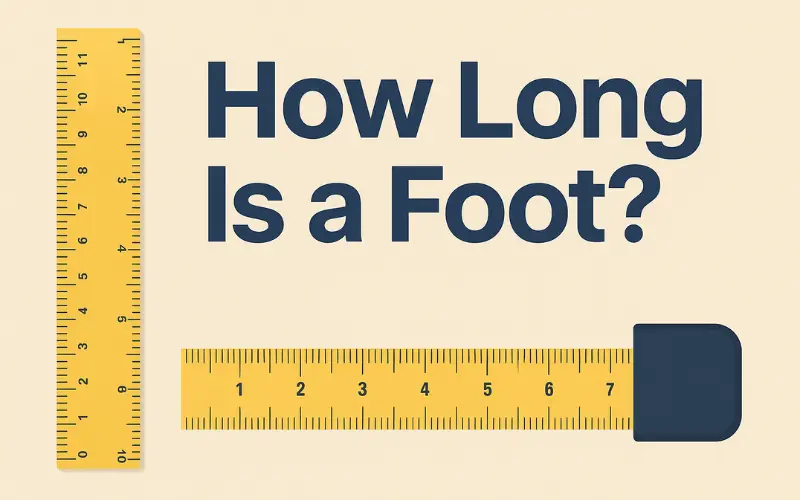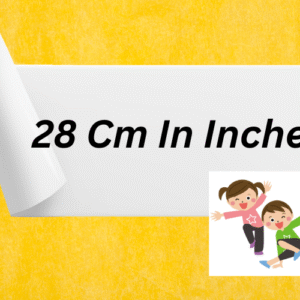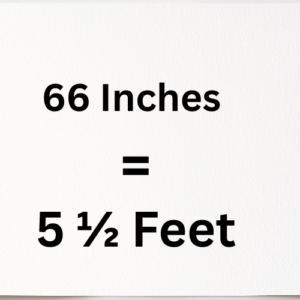When someone says “one foot,” it can be hard to picture exactly how long is a Foot. You might think of your own foot, but did you know that one foot is actually a fixed measurement used all over the world? It’s not just for shoes—it’s used in classrooms, construction sites, and even sports fields.
In simple terms, 1 foot equals 12 inches or 30.48 centimeters. That’s a size you’ll notice in many everyday things—like a ruler, a shoebox, or a laptop. Understanding how long a foot is helps you measure space, plan projects, and accurately assess the size of objects.
In this guide, we’ll make “a foot” easy to imagine by showing you 13 real-life objects that are about one foot long. By the end, you’ll be able to picture this length instantly—whether you’re decorating a room, measuring furniture, or just satisfying your curiosity about everyday measurements.
Have A Look On Our Free Foot to Inches Converter Tool
What Is a Foot?

The foot is a fundamental unit of measurement, used in everything from construction to everyday tasks like measuring furniture. But how long is a foot, exactly? This article provides a detailed exploration of the foot’s length, its historical significance, and its relevance today. By showcasing 13 objects that are approximately 1 foot long, we make this measurement relatable through familiar items. Whether you’re a student, DIY enthusiast, or curious reader, this guide offers practical insights, conversions, and tips to help you visualize a foot, optimized for clarity and searchability.
Defining the Foot: How Long Is It?
A foot is defined as exactly 12 inches in the imperial system, equivalent to 30.48 centimeters (since 1 inch = 2.54 cm, standardized in 1959). This makes it a precise and versatile unit for medium-scale measurements, such as room dimensions or furniture sizes. Roughly the length of an average adult’s foot, it’s a relatable size for everyday use. Its standardization ensures consistency across industries like construction, engineering, and education, making it a cornerstone of measurements in countries like the U.S. and UK.
Historical Context

The foot has ancient origins, derived from the Latin pes and Old English fot, reflecting its basis in the human foot’s length. Historically, its size varied:
The Roman pes was about 11.6 inches (29.6 cm).
Medieval England used feet ranging from 10 to 13 inches, depending on the region.
The French pied du roi was approximately 12.8 inches (32.5 cm).
In 1959, the international yard and pound agreement standardized the foot as 0.3048 meters (30.48 cm), ensuring global uniformity. This standardization eliminated discrepancies, making the foot a reliable unit for modern applications, from architecture to manufacturing.
Converting a Foot to Other Units
To understand a foot’s length, conversions to other units are helpful:
Metric System Conversions
Centimeters: 1 foot = 12 inches × 2.54 cm/inch = 30.48 cm.
Meters: 100 cm = 1 meter, so 1 foot = 0.3048 meters.
Millimeters: 1 cm = 10 mm, so 30.48 cm = 304.8 mm.
Kilometers: 1 meter = 0.001 km, so 0.3048 meters = 0.0003048 km.
Imperial System Conversions
Inches: 1 foot = 12 inches.
Yards: 1 yard = 3 feet, so 1 foot = 0.3333 yards.
Miles: 1 mile = 5,280 feet, so 1 foot = 0.0001894 miles.
Conversion Table
| Unit | Equivalent to 1 Foot |
| Inches | 12 inches |
| Centimeters | 30.48 cm |
| Millimeters | 304.8 mm |
| Meters | 0.3048 m |
| Yards | 0.3333 yd |
| Miles | 0.0001894 mi |
| Kilometers | 0.0003048 km |
13 Things That Are 1 Foot Long
Comparison Table
| Object | Approximate Size | Notes |
| Standard Ruler | 12 inches | Exact measurement tool |
| Subway Footlong | 12 inches | Standardized sandwich length |
| Shoebox | ~12 inches | For adult shoes |
| Large Textbook | ~12 inches | Common in academic settings |
| Vinyl Record | 12 inches (diameter) | Standard LP size |
| Kitchen Cutting Board | ~12 inches | Medium-sized, household staple |
| Small Umbrella | ~12 inches (folded) | Compact, portable design |
| Laptop (Width) | ~12 inches | Compact models vary by brand |
| Desktop Monitor | ~12 inches (height) | Compact models, vary by brand |
| Yoga Block | ~12 inches | Used in fitness routines |
| Wall Clock | ~12 inches (diameter) | Common in homes or offices |
| Briefcase (Width) | ~12 inches | Professional accessory |
| Standard Clipboard | ~12 inches | For letter-sized paper |
Below are 13 common objects that are approximately 1 foot long, each described in a dedicated section with at least 150 words to provide a thorough visualization.
Standard Ruler

A standard 12-inch ruler, often called a “foot-long ruler,” is the most precise example of a foot. Commonly found in classrooms, offices, and workshops, these rulers are made of plastic, wood, or metal, with clear markings for inches and centimeters. They’re essential for students learning measurements, artists sketching designs, or carpenters cutting materials. A 12-inch ruler is portable, fitting into pencil cases or toolboxes, and its exact length makes it a reliable reference for visualizing a foot. For instance, when measuring fabric or wood for a project, a ruler provides a straightforward way to confirm 12 inches. Its widespread use in education and DIY settings ensures it’s a familiar tool, making it an ideal starting point for understanding the foot’s length in practical, everyday scenarios.
Subway Footlong Sandwich

A Subway “footlong” sandwich is a famous example, measuring exactly 12 inches long. Whether filled with turkey, meatballs, or veggies, this sandwich is standardized across Subway restaurants, making it a delicious and precise reference for a foot. Its popularity as a fast-food option adds a cultural element, as millions recognize the footlong as a satisfying meal. If you’re at a Subway and need to visualize a foot, ordering a footlong offers a tangible example. Its uniform length is perfect for teaching measurements or using as a visual aid in casual settings. The sandwich’s accessibility and familiarity make it a fun and relatable way to understand a foot, connecting food and measurement in a way that resonates with many.
Shoebox

A standard shoebox for adult shoes, such as sneakers or dress shoes, is typically around 12 inches long. Designed to fit shoes that are roughly a foot long for many adults, these boxes are found in closets, retail stores, or storage spaces. Their rectangular shape and sturdy construction make them a practical reference for visualizing a foot. For example, if you’re organizing a closet or packing items, a shoebox can serve as a quick guide to estimate 12 inches. Its common presence in households ensures accessibility, and its clear dimensions make it a reliable tool for teaching measurements or comparing lengths in DIY projects. Shoeboxes are also versatile, often repurposed for crafts or storage, adding to their utility as a measurement reference.
Large Textbook

Many large textbooks, such as those for college courses in biology or history, measure approximately 12 inches in height or width. These books are common in academic settings, making them a relatable reference for students and educators. Their size is ideal for visualizing a foot, as they’re often placed on desks or shelves. For instance, if you’re studying and need to estimate a foot, picking up a textbook provides a clear sense of the length. The weight and thickness of textbooks add a tactile element, enhancing the connection to the measurement. Their widespread use in education makes them a practical example for understanding a foot in scholarly contexts, especially for students or teachers working with academic materials.
Vinyl Record

A standard 12-inch vinyl record, used for LPs, has a diameter of approximately 1 foot. These records are iconic in music culture, found in collections, record stores, or vintage shops. Their circular shape and precise 12-inch diameter make them an exact example of a foot’s length. For music enthusiasts, holding a vinyl record offers a nostalgic way to visualize this measurement. For example, when setting up a turntable or discussing measurements, a vinyl record serves as a unique reference. Its cultural significance and distinct size make it an engaging way to connect music and measurement, appealing to collectors, musicians, and casual listeners who want a tangible example of a foot.
Kitchen Cutting Board

A medium-sized kitchen cutting board is often around 12 inches long or wide. Used for chopping vegetables, meats, or fruits, these boards are a staple in home kitchens. Made of wood, plastic, or bamboo, their rectangular shape and sturdy build make them a reliable reference for a foot. If you’re preparing a meal and need to estimate 12 inches, a cutting board can serve as a guide. Its presence in most households ensures accessibility, and its practical use in cooking makes it a relatable example for home cooks or chefs. The cutting board’s flat surface also makes it useful for visualizing measurements in culinary projects or teaching kitchens, bridging food preparation and measurement.
Small Umbrella (Folded)

A compact, foldable umbrella, when closed, is often around 12 inches long. Designed for portability, these umbrellas fit into bags or purses, making them a common item for travel or commutes. Their length makes them a great example of a foot, as they’re widely used and easily recognized. If you’re caught in the rain and need to estimate a foot, a folded umbrella provides a quick visual. Its lightweight, cylindrical design adds practicality, and its presence in everyday life makes it a relatable reference for visualizing 12 inches in various scenarios, from travel to emergency preparedness. Umbrellas are also durable, ensuring they’re a consistent measurement tool.
Laptop (Width)

The width of many compact laptops, such as 13-inch MacBooks or ultrabooks, is approximately 12 inches. While screen sizes are measured diagonally, the physical width of the laptop’s body aligns closely with a foot. This makes laptops a familiar reference for tech users. For example, if you’re setting up a workspace and need to estimate a foot, placing your laptop on the desk offers a quick visual. The sleek, rectangular design and ubiquity of laptops in homes and offices make them a practical example, bridging technology and measurement. Laptops are especially relatable for students, professionals, or remote workers who use them daily.
Desktop Monitor (Height)

The height of a small desktop monitor, such as a 19-inch or 22-inch model, is often close to 12 inches (excluding the stand). These monitors are common in offices, homes, or gaming setups, making them a familiar reference for tech users. If you’re setting up a workstation and need to visualize a foot, checking the height of your monitor can help. Its flat, rectangular shape and clear dimensions make it a practical example, connecting technology and measurement in everyday life. The monitor’s presence in workspaces ensures it’s an accessible tool for visualizing a foot, especially for those working in tech or office environments.
Yoga Block

A standard yoga block, used in fitness and stretching routines, is often around 12 inches long. Made of foam, cork, or wood, these blocks help with balance and flexibility in yoga practice. Their rectangular shape and consistent size make them a great example of a foot, especially for fitness enthusiasts. If you’re in a yoga class or home gym and need to estimate 12 inches, a yoga block provides a clear visual. Its lightweight design and common use in exercise settings make it a relatable reference, bridging health and measurement for active individuals. Yoga blocks are also portable, making them a practical tool for visualizing a foot on the go.
Wall Clock (Diameter)

Many wall clocks, especially medium-sized models for homes or offices, have a diameter of approximately 12 inches. These clocks are designed for visibility and aesthetics, making them a common household item. Their circular shape and foot-long diameter provide a precise reference for visualizing a foot. For example, if you’re decorating a room and need to estimate 12 inches, glancing at a wall clock can help. Its decorative appeal and widespread use in homes, schools, or offices make it a relatable and engaging example for understanding this measurement, especially for those who value both function and style.
Briefcase (Width)

The width of a standard briefcase, used for carrying documents or laptops, is often around 12 inches. These briefcases are common among professionals, fitting neatly into work bags or under desks. Their rectangular shape and sturdy construction make them a practical reference for a foot. If you’re at work or traveling and need to estimate 12 inches, a briefcase can serve as a quick visual. Its professional context and portability ensure it’s a relatable example, especially for businesspeople or students carrying essentials. Briefcases are also durable, making them a consistent reference for visualizing a foot in professional settings.
Standard Clipboard

A standard clipboard, used for holding lists or notes, is typically around 12 inches long to accommodate letter-sized paper (11 inches). Found in offices, classrooms, or medical settings, clipboards are a familiar tool for organization. Their flat, rectangular design and consistent size make them a reliable reference for a foot. For example, if you’re taking notes or conducting a survey and need to visualize 12 inches, a clipboard provides a clear guide. Its widespread use in professional and educational settings ensures accessibility, and its simple design makes it a practical example for understanding a foot’s length in daily tasks.
Practical Applications of the Foot Measurement
The foot is used across various fields:
Construction: For measuring wall heights, floor dimensions, or stud spacing (e.g., 16 or 24 inches).
Architecture: In floor plans, where rooms are designed with foot-based measurements.
Fashion: For shoe sizes or fabric cuts, as an adult foot is roughly 1 foot long.
Sports: In field markings, like football yard lines (1 yard = 3 feet) or basketball courts.
Education: In teaching measurements, using foot-long rulers or textbooks.
Furniture Design: For table heights (~2.5 feet) or chair widths (~1 foot).
Read Also: How Long Is 100 Feet?
Tips for Measuring a Foot Without a Ruler
If you lack a ruler, try these methods:
Foot Length: An average adult male’s foot (size 9–11) is about 10–12 inches.
Letter Paper: A sheet of U.S. letter paper (11 inches) is slightly shorter; add a finger’s width.
Stride Length: A small step is about 2–3 feet; estimate a third for a foot.
Arm Span: The distance from wrist to elbow is often close to 12 inches.
Shoebox: Use a shoebox, typically around 12 inches long.
FAQs
How long is a foot in centimeters?
A foot is exactly 30.48 centimeters.
Why is it called a foot?
It’s named after the average length of a human foot, historically used for measurement.
What’s a common object that’s one foot long?
A standard ruler, Subway footlong, or shoebox are great examples.
How can I estimate a foot without a ruler?
Use a shoebox (~12 inches), letter paper (11 inches), or your own foot (~10–12 inches).
Is a foot the same worldwide?
Yes, since 1959, it’s been standardized as 12 inches or 0.3048 meters globally.
Conclusion
Now you know exactly how long a foot really is — 12 inches or 30.48 centimeters. It might sound small, but it’s one of the most useful measurements in daily life. From building furniture and hanging pictures to measuring fabric or checking shoe sizes, understanding a foot helps you make quick, smart decisions.
When you think of a foot, just picture a ruler, a shoebox, or a Subway footlong sandwich — they’re all about the same length. These everyday examples make it easy to imagine what one foot looks like, even without a measuring tool.
So the next time someone asks, How long is a foot?, you’ll know the answer and have real-life examples to explain it. It’s a simple length, but once you start noticing it, you’ll see how often this little measurement shows up everywhere around you.
Convert Inches to Meters, cm, mm, and Feet
Converted Values:
Meters (m): 1.016
Centimeters (cm): 101.60
Millimeters (mm): 1016.00
Feet (ft): 3.33





